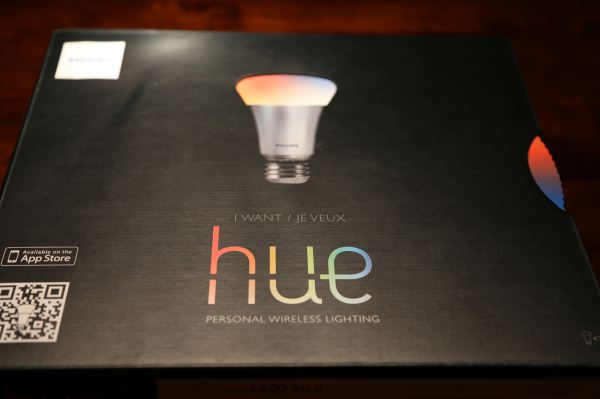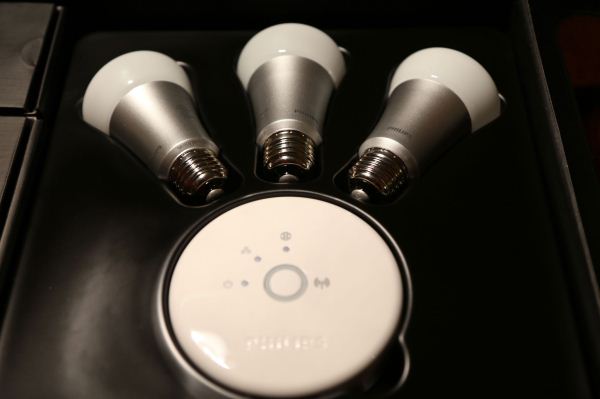Philips Hue: Automated Home Lighting Gets Colorful
by Ashu Joshi on March 1, 2013 12:50 AM EST- Posted in
- Gadgets
- Home Automation
- Philips
- Hue
- Lighting
Introducing the Philips Hue
Before we get started, we’d like to introduce Ashu Joshi to our readers. He has a background in networking and has used a variety of home automation devices over the years. As such, he brings a useful perspective to our staff and can help augment our review coverage. Note also that as with all of our articles, these pieces reflect the opinions of the writer(s) and are not in any way associated with or influenced by any other source (e.g. other employers).
Philips sent out a review sample of their new Hue lighting system, a set of three Hue lights with the Hue Bridge that allows you to remotely control the lights. Besides being able to turn the lights on or off, the big claim to fame of the Hue is that you can set the lights to a variety of colors, or you can even program them to cycle through colors. Home automation systems are often proprietary and can be quite expensive, so the entry of Philips into this market (albeit in a limited fashion) with their Hue lighting system has the potential to shake things up a bit.
The lights have colored LEDs, and while the initial pack only includes three Connected Bulbs (referred to informally as "bulb" or "light" throughout the remainder of this review), you can potentially add up to 50 lights throughout your house/property. One thing that hasn’t changed yet however is that pricing is quite high: the initial Starter Pack will set you back $200. But how does the Philips Hue work in practice, and could it be worth the cost of entry? Note that at present, the Philips Hue is only appears to be sold through the Apple Store as an “App-Enabled Accessory”, but Android is also supported. Long-term we will likely see support for other operating systems as well, but for now this is primarily an iOS/Android targeted device.
Packaging and Contents
One thing that immediately stands out with the Philips Hue is the packaging. It’s very well designed and eye-catching, and I love that you’re able to get a preview of the lighting options with the dial on the box. I set up my Philips Hue controller and bulbs recently, and my initial impressions have been very positive. It’s very easy to install and the experience of this lighting system is quite the change from your everyday lights. I uploaded a few videos of the package in action so you can see what it looks like.
Included in the package are three Connected Bulbs, and they’re quite a bit heavier than a typical light bulb. Most likely the added weight comes from the controller and antenna necessary to talk to the network, and possibly the addition of multi-colored LEDs adds a bit as well. Whatever the reason for the added weight, at least the heft makes you feel like you’re getting a bit extra for the $60 per light.
The other major item included with the Starter Pack is the Hue Bridge. This is a small, circular, lightweight controller with three LEDs on the top and a large circular button in the center used for the pairing function—Philips refers to it as the “link” button. On the side is an Ethernet port to connect to the home network and a power receptacle. The three LEDs show the status of Power, Ethernet, and Internet connections. There is no lettering to indicate what the LEDs are for but they use fairly common icons to indicate the function.
You also get a power adapter with a reasonably long cable for the Hue Bridge, though this is somewhat subjective. I have seen plenty of products where to save pennies they have short cables that ruin the setup experience and force the use of an extension cord, but for most users the Hue adapter should prove sufficiently long. An Ethernet cable is also provided to connect the Hue Bridge to your network, so plan ahead and realize that the Hue Bridge will need both power and network wires and place it accordingly.


















94 Comments
View All Comments
melgross - Friday, March 1, 2013 - link
I began moving to compact fluorescents a couple of decades ago, and now I'm moving to LEDs. Until recently, LEDs have been too expensive ($125 for a 450 lumen bulb), but have dropped considerably ($30 for an 800 lumen bulb). One problem was that the brightness of LED bulbs weren't really known because standards weren't there, or being followed. I'm now finding that they are.I've experimented with a lot of these over the years, including naked chips up to 100 watts (vast light output, but terrible color, and requiring a massive heatsink. Which reminds me, the reason why these bulbs weigh so much is because of the heatsinks. That rear portion of the bulb is an aluminum casting, which you can tell by tapping on it. LEDs do get very hot. It's the lack of infrared light in the output that keeps LED light cool. But the LEDs need a sink for the self heating they undergo (a major reason why OLED phone screens are so dim. The hotter an LED gets, the shorter the lifespan, and OLEDs can't run nearly as hot as can these silicon, carbide, etc. models can.)
But one disappointing part of this review is the lack of information as to the output of these bulbs. ARsTechnica also did a review of these some months ago. I don't remember if they said what the output is. Without knowing that, it's difficult to know how useful these are. For some people, dim rooms are fine, but for others, the room must be bright. So what are these equivalent to? Are we getting 400 lumens, 500, 600?
BravoRomeo - Sunday, April 7, 2013 - link
Philips specs the Hue at 600, depending on color temperature. Supposedly it derates itself if it gets too hot, so you might loose some brightness in a poorly ventilated fixture.I found the Hue bulbs comparable to a 60W GE Reveal incandescent. In fact, it was able to tune the color of Hue to exactly match the Reveal bulb, but without the heat... All you do is shift the hue a notch or two towards red/yellow and away from green, and a touch less saturated, which is what the filtering on the Reveal bulb does. Very impressive.
foxalopex - Friday, March 1, 2013 - link
I've bought a few LED bulbs over history and they've impressed me. They're definitely the next generation compared to compact fluorescents. They turn on instantly and you never have to worry about breaking the bulb if you turn it on and off a lot. Granted there are some problems too. Cheapo LED bulbs like the ones you can get from Walmart sometimes have the problem of the ballast dying if used for a long time. I have some expensive ones too and they've worked great except for slight FM radio interference. They're also horrifically expensive but that's not a surprise since the LED components are pretty pricy. Still I think it's just a matter of time.JeffFlanagan - Friday, March 1, 2013 - link
Changing colors don't seem very useful unless the user is on LSD, but being able to red-shift home lighting after sunset could be very helpful for people who have trouble sleeping.Installing f.Lux on my PC to dim and redden the screen at night has greatly improved my ability to fall asleep, and I'd like to do the same with all my lighting.
halbhh2 - Friday, March 1, 2013 - link
"not to mention compared to incandescent lights you’re already cutting power use per light by about 55W, so it should come out as a large net savings..."'should' ??
Not.
Why did the reviewer stop there, without doing the very easy math?
Perhaps because the real cost comparison is the *opposite* in reality.
For instance, you might run 10 bulbs an average of 10 hours a day 365/year, saving about $200 on electricity in 1 year vs. incandescent.
And incandescent is *not* even the competition here, since most households run a mix of bulbs which include numerous compact flourescents. That's the real comparison.
In other words, the opposite conclusion is more valid: instead of a "large net savings" expect a *significant net cost*.
And that's fine if you really want these. Just don't fool yourself into thinking you are saving money.
Shame on the reviewer.
JarredWalton - Friday, March 1, 2013 - link
Full quote instead of your ellipses:"For the Starter Pack and three bulbs, you’re looking at around $1 per year, not to mention compared to incandescent lights you’re already cutting power use per light by about 55W, so it should come out as a large net savings (though not compared to running non-connected LED lights everywhere)."
Obviously, we could have listed CFLs along with LEDs, but that's not the point. The point is whether the additional power draw incurred by the use of ZigBee (home automation) is a concern, and the answer is that no, it's not. Compared to CFL (14W), even running 24/7 for a year you'd only be spending an extra $7-$8 per light. If you can get the CFL for about $2 compared to $60, you might break even over the life of the bulb but probably not. But then, a $2 CFL doesn't offer the colored lighting options or home automation, which is the main attraction here.
halbhh2 - Friday, March 1, 2013 - link
Ok, but I just did not read it that way, and I'm not a poor reader. Perhaps you should clarify the text, so that it doesn't give the wrong impression.Qwertilot - Monday, March 4, 2013 - link
Surely the energy use should be a concern?Its seemingly 0.4 watt continous vs 5 watt for the actual bulb, so if the light bulb is on for an average of two hours a day you've just *doubled* its yearly power usage. For many bulbs it'll be worse than that.
While the overall amounts aren't massive it really does seem to be horribly gratitious.
If this is going to scale out to whole houses/lots more devices then it badly needs some way to power the radios almost entirely off when not required. Some master controller device and a mode where they poll every minute or something.
darkcrayon - Wednesday, March 6, 2013 - link
You could help save energy with them in other more unusual ways... I have mine set to turn off automatically when I leave my apartment which guarantees I can never leave them on by mistake - Using a proximity app that senses if my iPhone is in range. And my hallway light comes on to greet me when I get home after a certain hour. Of course, running a server to handle that easily negates that power difference (of course the server is for a myriad of other purposes and not just for home automation control).glugglug - Tuesday, March 5, 2013 - link
> And incandescent is *not* even the competition here, since most households run a mix > of bulbs which include numerous compact flourescents. That's the real comparison.Which brings up what for me is the main flaw in this product.
The bulbs are type A (LED approximation of a standard light bulb).
Most fixtures where you would use that type of bulb have a cover over them so a CFL is suitable and already uses almost the same power as an LED.
This would be a lot better if they made the bulbs for PAR30/PAR20/PAR38 where LEDs are a much better fit, and the only 2 real choices are LED or incandescent/halogen, because CFLs are absolutely blinding in those types of fixtures.